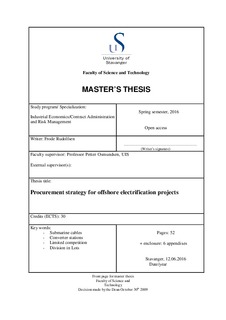| dc.description.abstract | Electrification of offshore installations has been an evaluated option for several platforms on the Norwegian Continental shelf (NCS). Offshore installations consume huge quantities of energy and for the majority of the installations the energy is made from burning natural gas in gas turbines locally. Electrification or Power From Shore solution, also called PFS-solution, is a technically complex system of components like submarine cables, offshore cable installation, transformer stations/converter stations, all which requires manufacturers and contractors with high competence and expertise. The PFS-solution must be safe, reliable and long lasting. Every meter of the submarine cable must work; only one weak spot in the cable will bring the whole power supply out of work, leaving the offshore platform without electricity.
There are limited number of qualified suppliers available in the market to deliver such type of solution, and the research aim is to focus on how the procurement strategy can be developed to achieve a technical viable and cost effective PFS-solution in a market with limited competition. Methods used: Transporting electrical power over long distances by cables is a technical challenge that is not being dealt with in detail in this report, but knowledge from other studies and projects are used to describe a feasible PFS-solution similar to other systems already built to date. The aim for this thesis is to develop a procurement strategy that best suits a technical solution, reduces the costs and gives an acceptable quality for the offshore electrification. HSE (Health Safety and Environment) is also a high priority factor in today’s projects and will be part of the award criteria in tender evaluation. To realize PFS-solution for an offshore platform is to a large degree depending on the total cost. If the cost can be kept down, chances for the implementation is much higher. PFS-solution is depending on both a technical viable solution, the supplier market must be large enough to give competition and sufficient manufacturing capacity and experience to deliver in time, with reliable quality to a competitive cost. If the procurement strategy is able to join all these factors the probability for a successful project will be high.
Findings of the research: Procurement strategy determines how the project in the best possible way can be specified and tendered to achieve the best possible and optimal result. By joining technical and contract knowledge with input from market situation and supplier competition, the probability for a successful project increases. Project of this size might have impact on competition between suppliers. The technical specification, cable manufacturing capacity, limited available capacity from few suppliers are key points to investigate as part of the procurement strategy development. Limited competition is a challenge and to create competition between the few suppliers the scope needs to be split in packages. The cost influence curve illustrates that the success of the projcect is decided in an early phase. By trying not to limit the technical PFS-alternatives and to keep both HVDC and HVAC solutions open until procurement phase, will give competition and alternatives for the developing company. Also allowing extruded DC cables as well as MI DC cables will give more competition.
Utsira selected as example PFS-project (200 km from shore to field center): (Example is based on open published references and documentation. There has been no contact with Statoil or other partners in the Utsira development project. All assumptions except from the ones in the reference list are writer’s own opinion based on experience).
Objective and goal is to supply the four offshore platforms at Utsira with up to 250-300 MW of electrical power from shore. Technically feasible with both DC-solution and AC solution. (AC solution is limited to about 240 to 250 MW). Limited number of suppliers/contractors available in market. Important to involve as many suppliers as possible to create competition and urge for cost effective solutions.
Definition of lots:
Lot 1: HVDC Converters (one onshore and one offshore),
Lot 2: Submarine HVDC cable(s) – approx. 200 km single core x 2. Voltage 200 kV.
Lot 3: Submarine AC cable(s) – approx. 82 km three core 66 kV.
Lot 4: HVDC Converters + Submarine HVDC cable and AC cable(s).
Lot 5: AC substations (one onshore 300 kV to 230 kV and one offshore 230 kV to 66 kV).
Lot 6: Submarine HVAC cable – approx. 200 km three core 230 kV.
Cost estimate of FPS-solution for Utsira example project is about 3500 MNOK for HVAC solution and about 4500 MNOK for HVDC solution. Estimated implementation time is about 4 years. AC solution is somewhat more cost effective that DC solution.
Conclusions and recommendations: Electrification of offshore platforms with power from shore requires a complex and costly system of submarine cables and transformer stations/converter stations. By applying specification allowing for more competition will bring down cost and provide for cost effective PFS-solution. Enough time needs to be allocated to secure a proper prequalification, tender and contract negotiation phase. By splitting the contract packages in Lots suitable for the contractors in the market, will allow focus on their core business, but also create interfaces. Company need experienced personnel to handle these complex interfaces. Target is to establish these interfaces where they are logic and clear, for example at the end of the submarine cable, connection to substation or converter station. | nb_NO |

